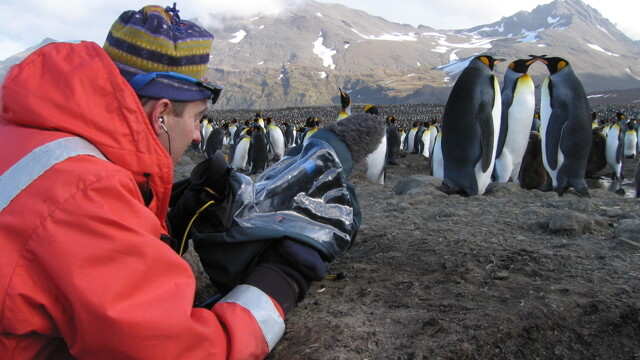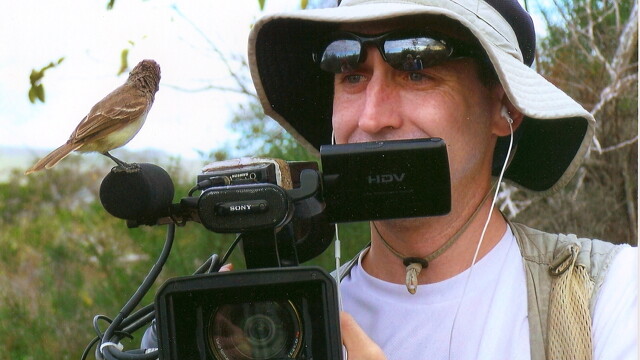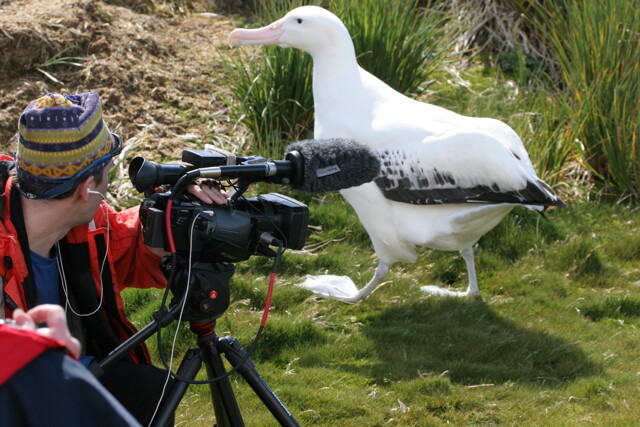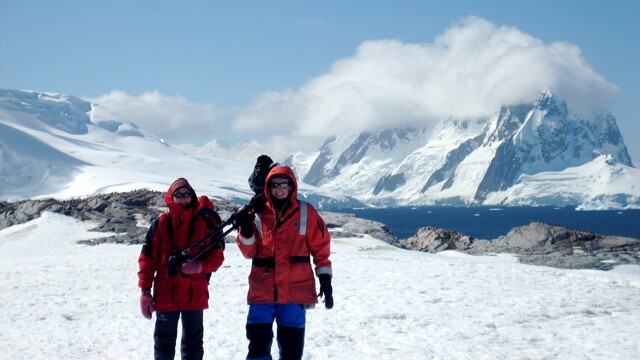Where the Wild Things Are
the travels of videographer Steve Ambroe

On a typical work day Eau Claire resident Steve Ambroe kisses his wife goodbye, grabs his gear, and heads out the door, off to work, just like gazillions of us. That’s pretty much where any similarities between your workday and his end. Your commute might involve a car or a bus or a bike. Steve’s commute involves a jet and a ship and sometimes even snowshoes.
“It is a real privilege to be able to go to so many incredible places. ... The other added perk for me is to be able to travel with and learn from National Geographic photographers.” – Eau Clairian Steve Ambroe, a world traveling nature videographer
Ambroe has one of the coolest jobs under the sun: he’s a video chronicler for Lindblad Expeditions and he regularly travels to the most remote and wild places on the planet. Alaska, Anarctica, the Galapagos Islands, Peru, Africa, and the list goes. Lindblad Expeditions was one of the first enterprises to introduce “eco-tourism” to the palate of adventure travel and tourism options back in the 50s and in 2004 the company partnered up with National Geographic. This alliance of two exploration pioneers created an innovative program for travelers to experience remote and pristine destinations around the globe. Expedition guests interact with world-renowned scientists, naturalists and researchers, uncovering stunning natural environments using state-of-the-art exploration tools – and Steve’s job is to chronicle and capture the essence of these experiences.
I caught up with Steve in between continents and poles for an interview. So enjoy a little armchair eco-travel, a little walk on the wild side ...
V1: Of all the places you go, is there one that you’re always excited to revisit?
SA: For a variety of reasons, it’s really hard to top a visit to the sub-Antarctic island of South Georgia.
The abundance of life here is just staggering with colonies of up to 200,000 nesting pairs of king penguins. All the associated activity in these colonies – the sounds of parents calling to chicks, and pungent smell – really gets imprinted in your brain. From a photographic standpoint, most of the Antarctic peninsula region has subdued colors of mostly blacks and whites, but in contrast South Georgia is full of wonderful colors. There is a splash of gold on the King Penguins, a vibrant green in the tussock grasses, and of course the deep blue of the hanging glaciers.

This island is a great story of conservation. Up until just over 100 years ago fur seals were still being hunted here almost to the point of extinction with only a few hundred remaining. After protection, these animals literally coat every foot of some beaches with population counts in the millions. History in the Antarctic region is so tangible, because the age of exploration there isn't really that old, only about 100 years ago. South Georgia is forever linked with Ernest Shackleton, perhaps the most well known of those early explorers.
V1: What are penguins like?
SA: Penguins are truly amazing creatures. On land they look awkward and kind of silly, but in the water they are so agile. They are incredibly tenacious and well adapted to the environment in which they live. The conditions can be incredibly harsh, but their ability to endure is what is so endearing. This is particularly true of the more southerly breeding species like adelie and emperor penguins. When the winds kick up it’s like they just turn up their coat collars and go on with life. They have jobs to do building nests and feeding chicks, and nothing gets in their way. It’s very admirable.
V1: What’s your most thrilling expedition?
SA: There are certainly thrilling components to any trip, but without a doubt the most intense for me is going to the Svalbard Archipelago in Arctic Norway. This area is well above the Arctic Circle, in fact the southernmost point is still well above the most northerly section of Alaska. These trips are particularly thrilling because anything can happen at literally any time of day. This far north the sun never sets, and we can get called out on deck to bright sunshine at 3AM. Why would we get up? Because someone has spotted a polar bear. These animals can be very hard to find with a creamy white coat in front of all white background of pack ice. After spotting a bear, the ship slowly inches forward often taking over 45 minutes on approach. Sometimes the bear will disappear in the ice, but maybe once or twice a season they will be curious and come right up to the bow of the ship. Everyone onboard is completely silent and still, and there is nothing quite like hearing the approaching foot falls or scratching sounds in the snow and ice caused by these great northern hunters.
V1: Can you say something about how the locals react to you?
SA: Each place is a little different. If I’m walking around with a tripod you get noticed. In Africa there are some places where people do not want to be videoed, so you always ask. Some of the markets in Africa where more tourists go, people want a bit of money if you take their picture. With video there’s an LCD screen that flips out and they really like that.

V1: Best travel moment with an animal?
SA: One of the best perks of my job is spending time with wildlife in “their” natural environments – where we are the guests in their domain. Last fall in southeast Alaska I was with a group hiking along a salmon stream and saw footprints and remnants of half eaten fish everywhere. It was quite obvious bears had been in the vicinity and just as we turned around to head back to our landing site, a beautiful brown bear emerged from the woods and waded into the stream. Collectively our hearts definitely skipped a beat, but it became readily apparent the bear was not interested in us but rather focused on the salmon making their way upstream. The agility of these large creatures is amazing as they leap over boulders and pounce on fish. This bear came within about 40 yards of the group at one point before walking with fish in mouth to the far shore. I've seen bears from ship before, but this encounter on land was definitely a highlight for me in 2010. I guess what I'm most taken with is the curiosity of animals everywhere. At different times I've had monkeys and even a lemur come right up to me, look closely, and then tug a little on the microphone attached to the side camera. It’s truly fascinating stuff.
V1: Can you say something about the environmental or sustainable integrity of the countries you visit? Have you noticed a change as you've traveled back to these places? Are there still pure places left?
SA: Most of the places I travel are incredibly beautiful, but have components in their ecosystems that are very fragile. This can be true of dry areas as different as the dry Baja California deserts or wet temperate rainforests in southeast Alaska. Visiting these kinds of places can transform people and transform their relationship with the natural world. But there certainly is a dichotomy going on as more people visit places considered off the beaten path. The Galapagos Islands are a good example. Tourism there has grown significantly there in the last few years, and it requires a high degree of management and regulation. But when people visit, they bring money into the economy, which can then be used to help conservation efforts. They also become advocates for the area when they return home.

Are there pure places left? It depends on one's definition of pure. In 2009 I visited some uninhabited desert islands, but the beaches were strewn with plastic refuse deposited there by ocean currents. The Antarctic peninsula is about as far from most human activity as you can get, but warmer wintertime temperatures are already affecting the range and nesting patterns of different species of penguins. Ultimately we are all in this together. In the videos I produce, I try to go beyond a simple trip slideshow and try to capture the compelling stories of the places people visit and why they are important.
V1: With a job like this where do you see yourself in five years?
SA: I’ve been doing this about six years and I got married in 2009, so I’m trying to phase down the amount of time I’m away. What I would like to do is to incorporate what I do out there and do it here, locally.
V1: After adventures in the most remote and pristine places of the planet, what’s it like to come back to EC?
SA: I often have to remind myself or ask myself, “What season is it?” When I first get back I just need some downtime to get caught up on sleep. Also traveling up the Northshore (of Minnesota) is one of my favorite things to do – it’s one of my favorite places on the planet.
V1: Anything else you'd like to share or say?
SA: It is a real privilege to be able to go to so many incredible places, and I feel really fortunate to be able to do so. The other added perk for me is to be able to travel with and learn from National Geographic photographers.


















